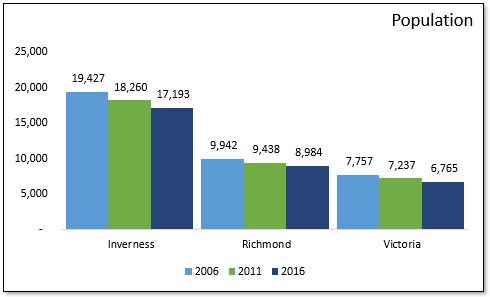The Economics and Statistics Division maintains archives of previous publications for accountability purposes, but makes no updates to keep these documents current with the latest data revisions from Statistics Canada. As a result, information in older documents may not be accurate. Please exercise caution when referring to older documents. For the latest information and historical data, please contact the individual listed to the right.
<--- Return to Archive
For additional information relating to this article, please contact:
March 08, 2017NOVA SCOTIA POPULATION ESTIMATES BY COUNTY - JULY 1, 2016 As of July 1, 2016, Nova Scotia's population was an estimated 949,501, a 0.6 per cent population increase (+6,128 persons) over the estimated 2015 population.
Halifax County's population was an estimated 426,083 persons, a 2.0 per cent increase (+8,198 persons) over 2015.
Between 2015 and 2016, only Halifax (+8,200), Annapolis (+49), Kings (+45), and Antigonish (+36) Counties saw population growth. In percentage terms, the county with the largest decline was Guysbrough County (-2.4% or -181 persons from 2015 to 2016). In absolute terms, the largest population decline occurred in Cape Breton County, which declined by 735 persons to 98,664. In all counties except Kings, Hants, Halifax, Colchester and Antigonish, the population has declined in at least 12 of the last 15 years.

Over the last ten years, the compound annual growth rate for provincial population has been growth 0.12 per cent per year. For Halifax, this figure is 1.03 per cent. Guysborough County has the largest decline, at an average annual decline of 2.29 per cent.
Halifax continues to grow faster than all other counties. Even in years where provincial population declines, Halifax continues to grow.

Population Change by County








Age Groups
The largest percentage of youth aged 0-17 years old among its population in 2016 could be found in Hants County, at 20.0 per cent, followed by Antigonish at 19.6 per cent. Guysborough County had the lowest percentage of youth among its population, at 13.1 per cent. As a whole, the province of Nova Scotia has 17.2 per cent of its population in this age group.

Halifax County has the largest percentage of population between the ages of 18 and 64 (67.6%), while Guysborough has the smallest (54.8%). Nova Scotia overall has 63.3 per cent of its residents in this age cohort.

Looking at the seniors population (Aged 65 and over), the largest proportion by county is in Guysborough (32.1%), while the lowest proportion was in Halifax (15.1%). As a province, Nova Scotia has 19.4 per cent of its population in this age cohort.

Components
Natural Increase (births minus deaths) was positive in three Counties from 2015 to 2016: Halifax (+1,211), Hants (+20), and Kings (+11). The largest natural decrease was in Cape Breton (-407).

Net International migration (Immigrants - emigrants + returning emigrants - net temporary emigrants + net non-permanent residents) was +7,528 for the province in the year leading up to July 1, 2016. Among the counties, this measure was highest in Halifax (+6,150) and lowest in Guysborough (-3). Over the last ten years, Halifax has averaged a positive 2,553 net international migrants.

Within the net international migration component, the net change in non-permanent residents residing in the province saw a notable increase in the year ending July 1, 2016, over its ten year average. In Nova Scotia, the number of non-permanent residents saw a net increase of 2,795 in the year ending July 1, 2016, compared to a ten year average of 965. A number of counties saw increases in net non-permanent residents last year, the most noteworthy being Halifax (+1,927 vs. a 10-year avg. of 698) and Cape Breton (+257 vs. a 10-year avg. of 126). In Nova Scotia, the vast majority of non-permanent residents are international students, followed by a smaller number of temporary foreign workers.

Net Interprovincial migration was negative in all but seven counties: Annapolis, Queens, Yarmouth, Shelburne, Victoria, and Antigonish all saw positive interprovincial migration while Digby's interprovincial migration was net-zero. However, net interprovincial migration improved in every county in 2015-2016 compared to 2014-2015. The County with the largest net interprovincial outmigration was Halifax, with -440 from 2015-2016.

Net Intraprovincial migration was negative in all but three counties: Halifax gained 1,277 persons, Lunenburg gained 82, and Cumberland gained 10 persons. The County with the largest net intraprovincial outmigration was Cape Breton, with -276 from 2015-2016.

Census Metropolitan Areas
The Halifax CMA grew 2.0 per cent from 2015 to 2016, the fastest growth east of Manitoba. Among CMAs in Canada, the highest growth in percentage terms was seen in Saskatoon which grew 3.2 per cent, followed by Regina (+2.6 per cent), Calgary and Edmonton (+2.5 per cent), and Winnipeg (+2.2 per cent). Moncton NB and St John's NL grew by 1.4 per cent and 1.5 per cent respectively between 2015 and 2016, and the population of Saint John NB increased by 0.4 per cent.

Source: CANSIM Tables 051-0062 Census Division), 051-0063 (Components of Population growth), and 051-0056 (CMA)
<--- Return to Archive